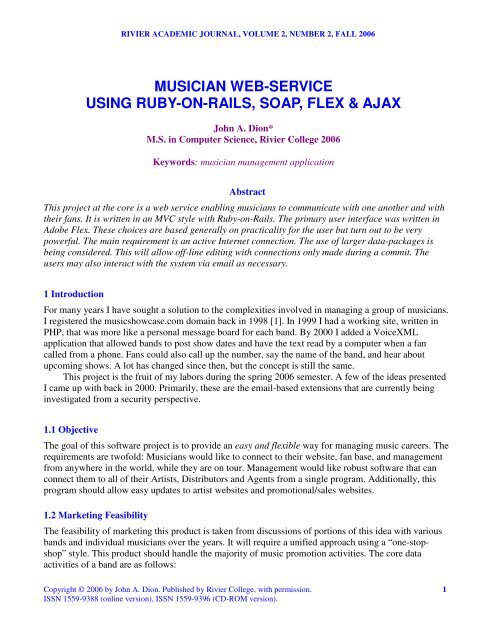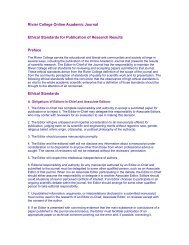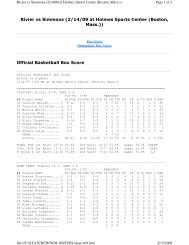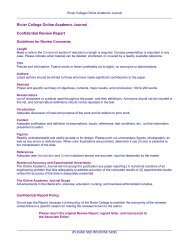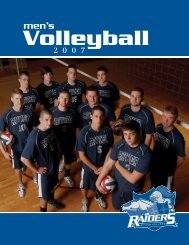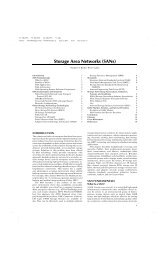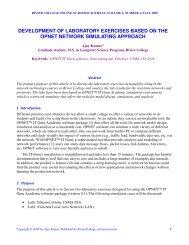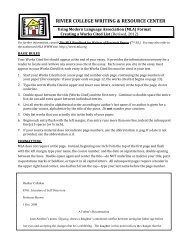musician web-service using ruby-on-rails, soap ... - Rivier University
musician web-service using ruby-on-rails, soap ... - Rivier University
musician web-service using ruby-on-rails, soap ... - Rivier University
Create successful ePaper yourself
Turn your PDF publications into a flip-book with our unique Google optimized e-Paper software.
RIVIER ACADEMIC JOURNAL, VOLUME 2, NUMBER 2, FALL 2006<br />
MUSICIAN WEB-SERVICE<br />
USING RUBY-ON-RAILS, SOAP, FLEX & AJAX<br />
John A. Di<strong>on</strong>*<br />
M.S. in Computer Science, <strong>Rivier</strong> College 2006<br />
Keywords: <str<strong>on</strong>g>musician</str<strong>on</strong>g> management applicati<strong>on</strong><br />
Abstract<br />
This project at the core is a <str<strong>on</strong>g>web</str<strong>on</strong>g> <str<strong>on</strong>g>service</str<strong>on</strong>g> enabling <str<strong>on</strong>g>musician</str<strong>on</strong>g>s to communicate with <strong>on</strong>e another and with<br />
their fans. It is written in an MVC style with Ruby-<strong>on</strong>-Rails. The primary user interface was written in<br />
Adobe Flex. These choices are based generally <strong>on</strong> practicality for the user but turn out to be very<br />
powerful. The main requirement is an active Internet c<strong>on</strong>necti<strong>on</strong>. The use of larger data-packages is<br />
being c<strong>on</strong>sidered. This will allow off-line editing with c<strong>on</strong>necti<strong>on</strong>s <strong>on</strong>ly made during a commit. The<br />
users may also interact with the system via email as necessary.<br />
1 Introducti<strong>on</strong><br />
For many years I have sought a soluti<strong>on</strong> to the complexities involved in managing a group of <str<strong>on</strong>g>musician</str<strong>on</strong>g>s.<br />
I registered the musicshowcase.com domain back in 1998 [1]. In 1999 I had a working site, written in<br />
PHP, that was more like a pers<strong>on</strong>al message board for each band. By 2000 I added a VoiceXML<br />
applicati<strong>on</strong> that allowed bands to post show dates and have the text read by a computer when a fan<br />
called from a ph<strong>on</strong>e. Fans could also call up the number, say the name of the band, and hear about<br />
upcoming shows. A lot has changed since then, but the c<strong>on</strong>cept is still the same.<br />
This project is the fruit of my labors during the spring 2006 semester. A few of the ideas presented<br />
I came up with back in 2000. Primarily, these are the email-based extensi<strong>on</strong>s that are currently being<br />
investigated from a security perspective.<br />
1.1 Objective<br />
The goal of this software project is to provide an easy and flexible way for managing music careers. The<br />
requirements are twofold: Musicians would like to c<strong>on</strong>nect to their <str<strong>on</strong>g>web</str<strong>on</strong>g>site, fan base, and management<br />
from anywhere in the world, while they are <strong>on</strong> tour. Management would like robust software that can<br />
c<strong>on</strong>nect them to all of their Artists, Distributors and Agents from a single program. Additi<strong>on</strong>ally, this<br />
program should allow easy updates to artist <str<strong>on</strong>g>web</str<strong>on</strong>g>sites and promoti<strong>on</strong>al/sales <str<strong>on</strong>g>web</str<strong>on</strong>g>sites.<br />
1.2 Marketing Feasibility<br />
The feasibility of marketing this product is taken from discussi<strong>on</strong>s of porti<strong>on</strong>s of this idea with various<br />
bands and individual <str<strong>on</strong>g>musician</str<strong>on</strong>g>s over the years. It will require a unified approach <str<strong>on</strong>g>using</str<strong>on</strong>g> a “<strong>on</strong>e-stopshop”<br />
style. This product should handle the majority of music promoti<strong>on</strong> activities. The core data<br />
activities of a band are as follows:<br />
Copyright © 2006 by John A. Di<strong>on</strong>. Published by <strong>Rivier</strong> College, with permissi<strong>on</strong>. 1<br />
ISSN 1559-9388 (<strong>on</strong>line versi<strong>on</strong>), ISSN 1559-9396 (CD-ROM versi<strong>on</strong>).
John A. Di<strong>on</strong><br />
I) Send and Receive communicati<strong>on</strong>s with fans (email and snail mail).<br />
II) Custom design their <str<strong>on</strong>g>web</str<strong>on</strong>g>site and/or use some provided templates.<br />
III) Reflect updates to the calendar in all c<strong>on</strong>necting comp<strong>on</strong>ents.<br />
IV) Schedule automatic sending of communicati<strong>on</strong>s.<br />
V) Add music to their <str<strong>on</strong>g>web</str<strong>on</strong>g>site.<br />
VI) Add an interface to their <str<strong>on</strong>g>web</str<strong>on</strong>g>site from their music compact disc.<br />
VII) Print flyers.<br />
VIII) Schedule gigs.<br />
IX) Resp<strong>on</strong>d automatically to email.<br />
To compete with all the diverse software that bands currently use, it would be ideal to implement as<br />
many of these features as possible.<br />
1.3 Benefits for Users<br />
The benefits for users are as follows:<br />
I) The band saves a lot of time by having all their data integrated in <strong>on</strong>e package.<br />
II) The fan is sure to receive timely and up-to-date informati<strong>on</strong> from the band.<br />
III) The band and/or management will save m<strong>on</strong>ey by being able to handle a lot of the details<br />
themselves.<br />
IV) The band will be easily c<strong>on</strong>nected with other bands in the same genre and the fan can be<br />
informed of bands they might be interested in checking out. This is comm<strong>on</strong>place marketing<br />
for small bands.<br />
1.4 Envir<strong>on</strong>ment<br />
Everything takes place <strong>on</strong> the <str<strong>on</strong>g>web</str<strong>on</strong>g>. C<strong>on</strong>necti<strong>on</strong>s for the band client are made from an Adobe Flash 9<br />
enabled <str<strong>on</strong>g>web</str<strong>on</strong>g> browser. The core comp<strong>on</strong>ents are: (1) a MySQL Database [2], (2) a Web-<str<strong>on</strong>g>service</str<strong>on</strong>g> written<br />
in Ruby-<strong>on</strong>-Rails [3], and (3) a Flash-based user interface written in Adobe Flex 2 [4].<br />
1.5 Approach<br />
The design is highly dependent <strong>on</strong> the MVC [see Glossary] architecture. A benefit of coding with Ruby<strong>on</strong>-Rails<br />
is the enforcement of this approach. Ruby is a purely object-oriented approach. Everything is<br />
an object, including numbers. An example of this would be obtaining the time <strong>on</strong>e minute from now,<br />
written as 1.minute_from_now. The programming is fairly straightforward because the code is clearly<br />
separated based <strong>on</strong> models, views, and c<strong>on</strong>trollers. The Object-relati<strong>on</strong>al Mapping (ORM) approach<br />
makes for very easy data manipulati<strong>on</strong> following the CRUD style [see Glossary].<br />
Copyright © 2006 by John A. Di<strong>on</strong>. Published by <strong>Rivier</strong> College, with permissi<strong>on</strong>. 2<br />
ISSN 1559-9388 (<strong>on</strong>line versi<strong>on</strong>), ISSN 1559-9396 (CD-ROM versi<strong>on</strong>).
MUSICIAN WEB SERVICE<br />
2 Functi<strong>on</strong>al Specificati<strong>on</strong><br />
Level 1 Functi<strong>on</strong>ality – This Project<br />
I. Calendar: Additi<strong>on</strong>s and changes to the calendar updates all necessary modules for the<br />
<str<strong>on</strong>g>web</str<strong>on</strong>g>site and schedule sending out automated email updates to fans.<br />
II. Mail: Standard messages sent and received between individuals and within groups.<br />
III. Management of multiple <str<strong>on</strong>g>web</str<strong>on</strong>g>sites <strong>on</strong> different physical servers.<br />
Level 2 Functi<strong>on</strong>ality<br />
IV. Multiple Artist Management: Manage multiple artists from a desktop client that c<strong>on</strong>nects to a<br />
remote server.<br />
V. C<strong>on</strong>tacts: The standard run-of-the-mill address book.<br />
VI. Style & Design Module: A basic design module that accepts any <str<strong>on</strong>g>web</str<strong>on</strong>g>site design.<br />
VII. Agent and Sales Staff: Additi<strong>on</strong>al functi<strong>on</strong>ality requests made by management.<br />
VIII. Forum: a forum that allows text and audio.<br />
IX. Audio streaming.<br />
X. Printing and sending flyers<br />
Future Versi<strong>on</strong>s<br />
Stateless Email applicati<strong>on</strong> data transfer.<br />
Mobile ph<strong>on</strong>e / PDA.<br />
Messages sent from ph<strong>on</strong>e are posted <strong>on</strong> the <str<strong>on</strong>g>web</str<strong>on</strong>g>site (text and voice).<br />
2.1 Case Study<br />
In <strong>on</strong>e of my previous bands, I was in charge of handling all communicati<strong>on</strong>s via the <str<strong>on</strong>g>web</str<strong>on</strong>g>, ph<strong>on</strong>e, email,<br />
and standard mail. It was actually quite time-c<strong>on</strong>suming. I had a program to make updates to the<br />
<str<strong>on</strong>g>web</str<strong>on</strong>g>site, a program to transfer the data to the <str<strong>on</strong>g>web</str<strong>on</strong>g>site, and a separate email client set up to send out<br />
mailings to the fans. I had to manually add people to the email list. Generally, people would sign up at<br />
gigs, or just visit our <str<strong>on</strong>g>web</str<strong>on</strong>g>site and send an email to us. I used another program to design and type up<br />
flyers. I needed clip art to make the site and flyers less bland. It was quite tedious.<br />
2.2 Required Functi<strong>on</strong>ality<br />
In additi<strong>on</strong> to what is specified in the functi<strong>on</strong>al spec, there are major security requirements. The<br />
majority of the time spent in coding this applicati<strong>on</strong> was creating a secure, sessi<strong>on</strong> based login manager.<br />
I need to add some state to compensate for the stateless HTTP protocol. A sessi<strong>on</strong> manager was<br />
designed that handles the task without putting undue load <strong>on</strong> the database and server. Once a pers<strong>on</strong> is<br />
authenticated, then all calls to the <str<strong>on</strong>g>service</str<strong>on</strong>g> pass through the sessi<strong>on</strong> manager. The sessi<strong>on</strong> ID is a unique<br />
random key that is stored in the database and deleted up<strong>on</strong> closure of the sessi<strong>on</strong>. No cookies are used.<br />
The sessi<strong>on</strong> is validated <strong>on</strong> every call to the <str<strong>on</strong>g>service</str<strong>on</strong>g> to c<strong>on</strong>firm that the user has access to that data. Only<br />
Copyright © 2006 by John A. Di<strong>on</strong>. Published by <strong>Rivier</strong> College, with permissi<strong>on</strong>. 3<br />
ISSN 1559-9388 (<strong>on</strong>line versi<strong>on</strong>), ISSN 1559-9396 (CD-ROM versi<strong>on</strong>).
John A. Di<strong>on</strong><br />
data that a user is authorized to modify may be modified. The complexity of the task is a c<strong>on</strong>sequence of<br />
allowing many bands to c<strong>on</strong>nect through the same database simultaneously.<br />
The complexity is further exacerbated by the need to allow the client run <strong>on</strong> machines other than<br />
the host machine. This Flash-based client will run <strong>on</strong>ly from authenticated domains. On the server side<br />
is a crossdomain.xml that restricts c<strong>on</strong>necti<strong>on</strong>s from clients that have not registered.<br />
2.3 Extended Functi<strong>on</strong>ality<br />
The client is capable of being coded with multiple user-interfaces. A DLL file was compiled from the<br />
<str<strong>on</strong>g>web</str<strong>on</strong>g>-<str<strong>on</strong>g>service</str<strong>on</strong>g> WSDL file early <strong>on</strong>. A quick feasibility test was d<strong>on</strong>e <strong>on</strong> the login manager to c<strong>on</strong>firm the<br />
viability of the approach.<br />
3 System Requirements<br />
3.1 Server-side<br />
• MySQL database.<br />
• Ruby-<strong>on</strong>-Rails capable <str<strong>on</strong>g>web</str<strong>on</strong>g> hosting provider.<br />
• A lighttpd server with Fast-CGI.<br />
• Server RAM and CPU is handled by any standard shared hosting provider.<br />
3.2 Client-side<br />
• Any browser capable of running Adobe Flash versi<strong>on</strong> 9.<br />
3.3 Additi<strong>on</strong>al Requirements<br />
• A high-speed Internet c<strong>on</strong>necti<strong>on</strong>.<br />
4 Implementati<strong>on</strong><br />
Server Side<br />
A Web-<str<strong>on</strong>g>service</str<strong>on</strong>g> coded in Ruby-<strong>on</strong>-Rails that promotes MVC, CRUD, ORM and testing [see Glossary for<br />
all definiti<strong>on</strong>s]. Coding in Rails starts with the core CRUD and adds to the design as it develops. After<br />
writing the core CRUD that c<strong>on</strong>nect through simple html forms, some basic testing is d<strong>on</strong>e to make that<br />
data manipulati<strong>on</strong> is working as intended.<br />
Client Side<br />
An Adobe Flex-based client that can be incorporated into any <str<strong>on</strong>g>web</str<strong>on</strong>g>site. When some<strong>on</strong>e signs up for the<br />
<str<strong>on</strong>g>service</str<strong>on</strong>g> the crossdomain.xml file is dynamically updated to allow for access to the Web <str<strong>on</strong>g>service</str<strong>on</strong>g> from the<br />
user’s selected domain.<br />
Core Modules<br />
• Calendar: Updates to this calendar can update all necessary modules for the <str<strong>on</strong>g>web</str<strong>on</strong>g>site and schedule<br />
sending out automated email updates to fans.<br />
• Mail: Standard messages sent and received to individuals and/or a list.<br />
Copyright © 2006 by John A. Di<strong>on</strong>. Published by <strong>Rivier</strong> College, with permissi<strong>on</strong>. 4<br />
ISSN 1559-9388 (<strong>on</strong>line versi<strong>on</strong>), ISSN 1559-9396 (CD-ROM versi<strong>on</strong>).
MUSICIAN WEB SERVICE<br />
• C<strong>on</strong>tacts: The standard run-of-the-mill address book.<br />
• Security.<br />
4.1 Use Case Scenario<br />
4.2 User-interface State Chart<br />
Figure 4.1.1: Use-Case Scenario.<br />
Figure 4.2.1: Use-Interface State Chart.<br />
Copyright © 2006 by John A. Di<strong>on</strong>. Published by <strong>Rivier</strong> College, with permissi<strong>on</strong>. 5<br />
ISSN 1559-9388 (<strong>on</strong>line versi<strong>on</strong>), ISSN 1559-9396 (CD-ROM versi<strong>on</strong>).
John A. Di<strong>on</strong><br />
4.3 Web-<str<strong>on</strong>g>service</str<strong>on</strong>g> Functi<strong>on</strong>s<br />
Core API Methods<br />
member_remove – implemented <strong>on</strong>ly in n<strong>on</strong>-flex applicati<strong>on</strong><br />
Allows the administrator to remove the member.<br />
member_add – implemented in all<br />
Add a member is handled during signup.<br />
member_view – implemented in all<br />
Individual member details, not viewable by user.<br />
member_edit – implemented <strong>on</strong>ly in n<strong>on</strong>-flex applicati<strong>on</strong> for security reas<strong>on</strong>s<br />
member_login – implemented in all<br />
Login informati<strong>on</strong>, not viewable by user.<br />
member_logout – implemented in all<br />
Logout call, sessi<strong>on</strong> closed.<br />
get_band_id – implemented in all<br />
Band id associated with this user, not viewable by user.<br />
c<strong>on</strong>tact_remove – implemented in all<br />
C<strong>on</strong>tact removed by user id after being authenticated against the member id.<br />
c<strong>on</strong>tact_add – implemented in all<br />
C<strong>on</strong>tact added and associated with band id.<br />
c<strong>on</strong>tact_view – implemented in all<br />
C<strong>on</strong>tact viewed <strong>on</strong>ly after being authenticated against the member id.<br />
c<strong>on</strong>tact_list – implemented in all<br />
C<strong>on</strong>tacts viewed <strong>on</strong>ly after being authenticated against the member id.<br />
c<strong>on</strong>tact_edit – implemented in all<br />
C<strong>on</strong>tact edited by user id after being authenticated against the member id.<br />
gig_remove – implemented in all<br />
Event removed after being authenticated against the member id.<br />
gig_add – implemented in all<br />
Event added and associated with band id.<br />
gig_view – implemented in all<br />
Event viewed after being authenticated against the member id.<br />
gig_edit – implemented in all<br />
Event edited after being authenticated against the member id.<br />
gig_list – implemented in all<br />
Events viewed after being authenticated against the member id.<br />
job_remove – implemented <strong>on</strong>ly in n<strong>on</strong>-flex applicati<strong>on</strong> for security reas<strong>on</strong>s<br />
job_add – implemented <strong>on</strong>ly in n<strong>on</strong>-flex applicati<strong>on</strong> for security reas<strong>on</strong>s<br />
job_view – implemented <strong>on</strong>ly in n<strong>on</strong>-flex applicati<strong>on</strong> for security reas<strong>on</strong>s<br />
job_edit – implemented <strong>on</strong>ly in n<strong>on</strong>-flex applicati<strong>on</strong> for security reas<strong>on</strong>s.<br />
4.4 Implementati<strong>on</strong> Details<br />
A SOAP-based remote procedure call is made from the client base <strong>on</strong> a user acti<strong>on</strong>. All data is passed<br />
through the <str<strong>on</strong>g>web</str<strong>on</strong>g>-<str<strong>on</strong>g>service</str<strong>on</strong>g> API called bandmanager_api.rb. The implementati<strong>on</strong> for the bandmanager_api<br />
Copyright © 2006 by John A. Di<strong>on</strong>. Published by <strong>Rivier</strong> College, with permissi<strong>on</strong>. 6<br />
ISSN 1559-9388 (<strong>on</strong>line versi<strong>on</strong>), ISSN 1559-9396 (CD-ROM versi<strong>on</strong>).
MUSICIAN WEB SERVICE<br />
<str<strong>on</strong>g>web</str<strong>on</strong>g>-<str<strong>on</strong>g>service</str<strong>on</strong>g> can be found in bandmanager_c<strong>on</strong>troller.rb. These are the two core files for the client side.<br />
The c<strong>on</strong>troller maps all data to the appropriate data in the database. The request is returned to the client<br />
in a SOAP-based XML packet. The client side is heavily-involved in data binding for straight calls to<br />
the <str<strong>on</strong>g>web</str<strong>on</strong>g> <str<strong>on</strong>g>service</str<strong>on</strong>g>. However, more complex calls such as edits are passed handled by the datahandler<br />
functi<strong>on</strong>s in the musicshowcase.mxml Flex file.<br />
4.5 Screen Shots<br />
Figure 4.5.1: Login Screen<br />
Copyright © 2006 by John A. Di<strong>on</strong>. Published by <strong>Rivier</strong> College, with permissi<strong>on</strong>. 7<br />
ISSN 1559-9388 (<strong>on</strong>line versi<strong>on</strong>), ISSN 1559-9396 (CD-ROM versi<strong>on</strong>).
John A. Di<strong>on</strong><br />
Figure 4.5.2: Main Screen (Events).<br />
Figure 4.5.3: Add Event Screen.<br />
Copyright © 2006 by John A. Di<strong>on</strong>. Published by <strong>Rivier</strong> College, with permissi<strong>on</strong>. 8<br />
ISSN 1559-9388 (<strong>on</strong>line versi<strong>on</strong>), ISSN 1559-9396 (CD-ROM versi<strong>on</strong>).
MUSICIAN WEB SERVICE<br />
Figure 4.5.4: C<strong>on</strong>tacts Screen.<br />
Figure 4.5.5: Add a C<strong>on</strong>tact Screen.<br />
Copyright © 2006 by John A. Di<strong>on</strong>. Published by <strong>Rivier</strong> College, with permissi<strong>on</strong>. 9<br />
ISSN 1559-9388 (<strong>on</strong>line versi<strong>on</strong>), ISSN 1559-9396 (CD-ROM versi<strong>on</strong>).
John A. Di<strong>on</strong><br />
5 Testing<br />
5.1 Functi<strong>on</strong>al Testing<br />
All testing was d<strong>on</strong>e during development. Rails encourages incremental unit testing c<strong>on</strong>current with<br />
writing the applicati<strong>on</strong> code. It also has a somewhat strict MVC architecture. The automated testing<br />
available in Rails isn’t yet fully integrated into the <str<strong>on</strong>g>web</str<strong>on</strong>g> <str<strong>on</strong>g>service</str<strong>on</strong>g>. However, prior to writing the <str<strong>on</strong>g>web</str<strong>on</strong>g><br />
<str<strong>on</strong>g>service</str<strong>on</strong>g>, I found it helpful to start by writing a traditi<strong>on</strong>al applicati<strong>on</strong> with a minimal set of functi<strong>on</strong>s.<br />
Instead, all code can be tested from a page that links to the <str<strong>on</strong>g>service</str<strong>on</strong>g>. The coding is d<strong>on</strong>e in the<br />
development envir<strong>on</strong>ment that gives feedback <strong>on</strong> the results. Within this envir<strong>on</strong>ment a separate<br />
database is used. The program can then be made live with the flick of a switch.<br />
Here is a descripti<strong>on</strong> of the development / testing cycle. In Rails, you test each part as you go.<br />
There is no need to compile or reboot the server unless a change is made to the database structure. For<br />
this reas<strong>on</strong>, I started by carefully planning out the database structure. When you encounter a bug, you fix<br />
it immediately before moving <strong>on</strong>. That minimizes final bugs in the core data of the program.<br />
The user interface required a similar build / test cycle. It compiled <strong>on</strong> my machine in a few sec<strong>on</strong>ds.<br />
Then I would start testing and making adjustments.<br />
5.2 Test Results<br />
There are two core problems identified with this program so far. The first results from the fact that I had<br />
to implement the modal windows for editing with my own custom code (modal windows are not fully<br />
implemented in Flex Beta 2). I occasi<strong>on</strong>ally have had a c<strong>on</strong>diti<strong>on</strong> that caused the program to be modal<br />
when it should not be. This was the result of receiving incorrect data from the server. The incorrect data<br />
from the server was fixed and the bug has not appeared again since. The sec<strong>on</strong>d is that even though I<br />
ensure that a user is signed <strong>on</strong> and <strong>on</strong>ly interacts with their authorized data, I have not yet implemented<br />
any handling of errors <strong>on</strong> the server side. What basically happens is that if the <str<strong>on</strong>g>service</str<strong>on</strong>g> returns NULL,<br />
which it did <strong>on</strong>ly during development, a big message is displayed in Flash. Again, this <strong>on</strong>ly happened<br />
during development and has since been fixed. Basically, I covered all the standard cases for data passed<br />
between client and server. You will also notice some checks are d<strong>on</strong>e <strong>on</strong> the server side to ensure that<br />
the data is correct; if not, it will pass back a message to the client. This needed to be d<strong>on</strong>e <strong>on</strong> the server<br />
side to cover all future clients. However, for increased security, the data should be validated as much as<br />
possible <strong>on</strong> the client side, too.<br />
6 C<strong>on</strong>clusi<strong>on</strong><br />
This software project will be hosted <strong>on</strong> the domain http://www.musicshowcase.com for <str<strong>on</strong>g>musician</str<strong>on</strong>g>s that<br />
post their music there [1]. It uses Adobe Flash versi<strong>on</strong> 9 for the client-side. It was a very fun and<br />
challenging project to work <strong>on</strong>. I learned Flex [4] and Ruby [3] this semester but I already had a good<br />
foundati<strong>on</strong> <strong>on</strong> the remainder of topics through my educati<strong>on</strong> at <strong>Rivier</strong> College.<br />
6.1 Future Directi<strong>on</strong>s<br />
I plan to c<strong>on</strong>tinue this project. My current plans are to c<strong>on</strong>tinue building the core of the site and then<br />
integrate this applicati<strong>on</strong> with the rest of the applicati<strong>on</strong> hosted at http://www.musicshowcase.com/ [1].<br />
Copyright © 2006 by John A. Di<strong>on</strong>. Published by <strong>Rivier</strong> College, with permissi<strong>on</strong>. 10<br />
ISSN 1559-9388 (<strong>on</strong>line versi<strong>on</strong>), ISSN 1559-9396 (CD-ROM versi<strong>on</strong>).
MUSICIAN WEB SERVICE<br />
7 References<br />
[1] Di<strong>on</strong>, J. A. Project Main Website. Retrieved November 4, 2006, from http://www.musicshowcase.com/<br />
[2] MySQL. Retrieved November 4, 2006, from http://www.mysql.org/<br />
[3] Ruby <strong>on</strong> Rails. Retrieved November 4, 2006, from http://www.<str<strong>on</strong>g>ruby</str<strong>on</strong>g><strong>on</strong><strong>rails</strong>.org<br />
[4] Flex Beta 2. Retrieved November 4, 2006, from http://labs.macromedia.com/<br />
[5] AJAX: A New Approach to Web Applicati<strong>on</strong>s. Retrieved November 4, 2006, from<br />
http://www.adaptivepath.com/publicati<strong>on</strong>s/essays/archives/000385.php<br />
Glossary<br />
RAILS – Ruby-<strong>on</strong>-Rails is a way of programming that enforces MVC from the start [3]. At the core are<br />
many modules that allow for speed of development. CRUD and ORM are an integral part of Rails.<br />
CRUD – Acr<strong>on</strong>ym for the core functi<strong>on</strong>s of the database. Create, Retrieve (read), Update, and Delete.<br />
Rails focuses around CRUD and ORM if you use the scaffolding (highly recommended for learning<br />
Ruby) as a starting point.<br />
ORM – Object -relati<strong>on</strong>al mapping. In Rails, most objects directly map to the database; e.g., creating a<br />
new user maps directly to the ‘users’ table.<br />
MVC – Model-view-c<strong>on</strong>troller. A style of software design that keeps a clear separati<strong>on</strong> between the core<br />
comp<strong>on</strong>ents of a system. Simply put, the model is the logic for the data exchange. The view is<br />
generally the user interface. The c<strong>on</strong>troller handles the events in the system.<br />
MySQL – A popular database that is available at most developer focused <str<strong>on</strong>g>web</str<strong>on</strong>g> hosts [2].<br />
SOAP / RPC – A specific type of remote procedure call. Used to stand for simple object access protocol.<br />
But now it is just referred to as SOAP. Not the cleanest in that it has a lot of overhead compared to<br />
other RPCs, but well supported.<br />
AJAX – Asynchr<strong>on</strong>ous JavaScript and XML. A new style of programming JavaScript <strong>on</strong> the <str<strong>on</strong>g>web</str<strong>on</strong>g> that<br />
does not require refreshes of the entire page [5]. Only the comp<strong>on</strong>ents in a page that you want<br />
updated will refresh; e.g., Google maps and Amaz<strong>on</strong>’s A9.com search engine.<br />
FLEX – An XML style of coding Flash comp<strong>on</strong>ents [4]. The code is written in MXML and<br />
Acti<strong>on</strong>Script. After compilati<strong>on</strong>, you have a Flash SWF file that can be used <strong>on</strong> the <str<strong>on</strong>g>web</str<strong>on</strong>g>.<br />
___________________________________<br />
* JOHN DION received his M.S. in Computer Science from <strong>Rivier</strong> College in May 2006 and B.A. in Psychology from the<br />
<strong>University</strong> of West Florida in Pensacola, Florida in 1996. His current research interests are in Cognitive Science,<br />
Philosophy of Mind, Semantic Networks, and Human Computer Interacti<strong>on</strong> for users with disabilities. His pers<strong>on</strong>al<br />
interests include c<strong>on</strong>temporary Christian s<strong>on</strong>gwriting and homelessness preventi<strong>on</strong>. He is currently working as a c<strong>on</strong>tract<br />
programmer and <str<strong>on</strong>g>web</str<strong>on</strong>g> applicati<strong>on</strong> developer. He can be c<strong>on</strong>tacted at jdi<strong>on</strong>@musicshowcase.com.<br />
Copyright © 2006 by John A. Di<strong>on</strong>. Published by <strong>Rivier</strong> College, with permissi<strong>on</strong>. 11<br />
ISSN 1559-9388 (<strong>on</strong>line versi<strong>on</strong>), ISSN 1559-9396 (CD-ROM versi<strong>on</strong>).


